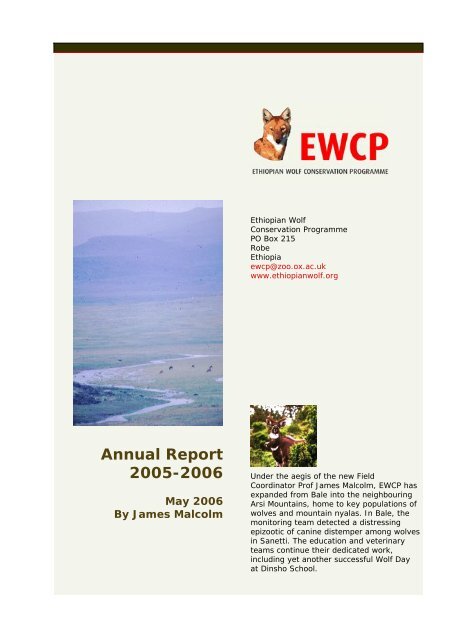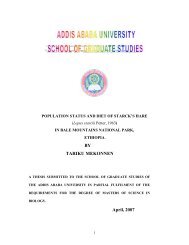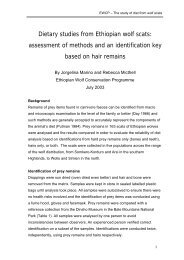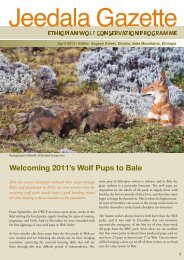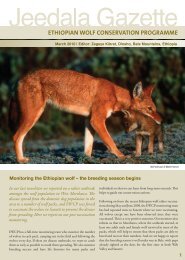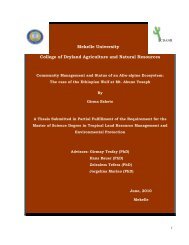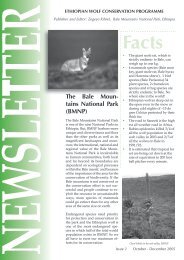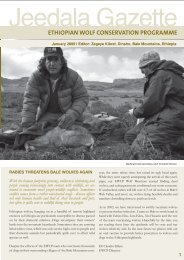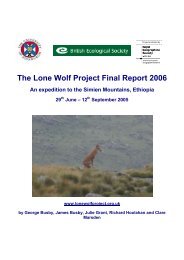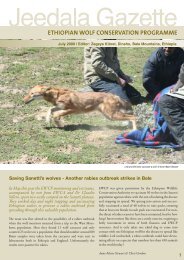pdf -640KB - Ethiopian Wolf Conservation Programme
pdf -640KB - Ethiopian Wolf Conservation Programme
pdf -640KB - Ethiopian Wolf Conservation Programme
You also want an ePaper? Increase the reach of your titles
YUMPU automatically turns print PDFs into web optimized ePapers that Google loves.
control, and support to protected areas andtraditional systems of sustainable use. Indoing so, it has strengthened the image of<strong>Ethiopian</strong> wolves as a flagship for theconservation of Afroalpine diversity andvaluable natural resources for thesurrounding communities, attractinginternational attention on the plight ofbiodiversity conservation and leverage forfunds.Due to small population sizes and thenature of the factors threatening <strong>Ethiopian</strong>wolves, it may necessary to manage thesepopulations in perpetuity. EWCP’s longtermvision is to seek sustainable solutionsto particular aspects the most seriousthreats, with a central role in monitoringand protection, while acting as a catalystand facilitator for other conservationinitiatives.promote sustainable development andcoexistence with wildlife conservation.Together with the funds provided by theFrankfurt Zoological Society (FZS) tosupport the Bale Mountains National Park,there is hope that real progress can bemade in the conservation of this area in thenext few years.We have recently produced a five-yearAchievements Report (2000-2004) 1 toevaluate the project success on the light ofthe <strong>Ethiopian</strong> <strong>Wolf</strong> Action Plan (IUCN) 2 andto ensure that goals and activities arerectified whenever necessary. This wasfollowed by a five-year Strategic Plan thatset up a direction for EWCP on the comingyears. This Annual Report informs on theproject activities for the period April 2005-March 2006, making reference to theobjectives of the Strategic Plan.In particular, the EWCP is set to continue toplay a significant role in the conservation ofthe Bale Mountains, providing expertise andinformation and in the practical benefits ofthe education and veterinary programs.Bale is a region of extraordinary biologicaldiversity and source of water resources forlarge parts of South Eastern Ethiopia.Former EWCP Coordinator Dr StuartWilliams was successful in leveraging a US$6,000,000 grant from the international aidcommunity for a project to be run by theNGO FARM Africa, working with the peoplein and around the Bale Mountains toThis year saw a continuation of our effortson four main areas: capacity building, wolfmonitoring, veterinary programme andeducation, and the initiation of anexpansion into the Arsi Mountains whichpromises to be very productive.4
Capacity building of <strong>Ethiopian</strong>institutions and peopleObjective: To increase the capacity ofEthiopia in the field of ecology, biodiversityconservation and protected areamanagement.Employment, training and recruitmentof EWCP staffIn Bale and Arsi we continue to employ<strong>Ethiopian</strong> staff in the Monitoring,Education and Veterinary Teams, andthose involved with project infrastructuremaintenance. The new personnel working inArsi (two Education Officers and a FieldAssistant) were trained by the Bale-basedteams on various project activities prior totheir deployment.where our staff can interpret theinformation and make informedmanagement decisions.Partnerships with national and localinstitutionsEWCP is one of the longer standingconservation organizations in Ethiopia andhas created a network of connections withother organisations in the country andbeyond. In particular we paved the way forthe Frankfurt Zoological Society to establisha project in the Bale Mountains. The FZSproject is aimed directly as building up thecapacity of the Bale Mountains NationalPark to do its job. We work in very closecooperation with FZS and its TechnicalAdvisor in Bale, Alastair Nelson. We haveenjoyed some clear benefits from thisassociation as FZS has improved the roads,built new accommodations and worked withthe staff of the National Park. Alastairoriginally worked for EWCP and continuesto help in many ways, especially withcomputers and vehicles.We provide on-going training to themembers of our staff involved in monitoringand veterinary work. In addition tocollecting data in the field most of themonitors can now enter information into acomputer. We have not reached the pointOur other major partnership is with theBale Mountains National Park. It isimportant that the park staff start to learnthe details of many of EWCP activitieswhich they will eventually help run. ThePark Expert Mahommednur Jamal (lowerlevel management staff), has beenassigned as James’ counterpart. Thus thecoordinator keeps him up to date on theveterinary and monitoring programs in5
particular. We have worked very closelywith the Park in the current distemperoutbreak and they have been fully briefedand taken part in decisions on theappropriate interventions needed, if any.Student trainingWe continue to assist with the formation ofyoung <strong>Ethiopian</strong> field biologists, incollaboration with Addis Ababa University,Wondo Genet Forestry College and BaleMountains National Park. In Bale weprovide students with logistic support at theResearch Building, including academicinput, IT support, library, field equipment,horses, field camps, and technical knowhow.This year we are sponsoring two universitydegrees: Leta Idea, our Veterinary Officer,is taking summer courses at DebubUniversity in Wildlife Management (afterfive years will earn a degree) andWoldemedhin Zebene, <strong>Conservation</strong> Officerfor the FZS Afroalpine Ecosystem<strong>Conservation</strong> Project (EWCP counterpart inNorthern Ethiopia), has a BSc in naturalresource management (Debub University).In March 2006, two biology graduatestudents from Addis Ababa Universityjoined EWCP and are funded by us. TarikuMekonnen is looking at the endemicStarck’s hare (Lepus starkii) andMohammed Abdi is looking at diet andfeeding in the giant molerat (Tachyoryctesmacrocephalus).Transfer of knowledgeThe newly created EWCP Newsletter (seeEducation section) not only informs localcommunities of the work of EWCP but alsodisseminates key knowledge on the biologyand conservation of wolves, and of thewhole Bale ecosystem.EWCP has sponsored two educationworkshops in the past year (see theEducation section) and these have providedvaluable training in the field ofEnvironmental Education.PhD students conducting research inassociation with EWCP presented their workto a relevant audience of conservationistsand scientist this year in Cambridge, at theStudent Conference of <strong>Conservation</strong>Science (28-30th March 2006). LucyTallents presented a paper on mapping theabundance of <strong>Ethiopian</strong> wolf prey andDeborah Randall on the genetic structure ofwolf populations in Bale.Our staff, students and collaboratingscientists produce a steady flow of scientificpublications. These and our annual reports6
perhaps the most complete set of data forany large carnivore population and certainlyfor an endangered species. In addition tothe main subpopulations, some wolves alsosurvive in sub-optimal habitat around them.In July, the monitors visited the extremewestern extension of the Bale Mountainsabove the town of Dodola. They report atleast four packs in that area.Map of Bale Mountains showing areas monitored by the EWCP Monitoring TeamPopulation trends- The total population inBale may have increased slightly, butdifferent subpopulations fared differently.Numbers of wolves in 17 packs in theMorabowa area seem to have heldconstant. Numbers in the Web Valley arebuilding back quickly from the rabiesepidemic of 2003 - from a low of 20 wolvesafter the disease to 45. All the pups thatlived to three months in 2005 survived andwere recruited into their home packs.Seven of the nine Web Valley packsproduced pups in September 2005 (for thesecond year in a row no pups were seen inthe Kotera pack). The nine packs of8Central Sanetti seem to have undergone amodest increase (but were later affected bydisease); a slightly separate group of fivepacks around the Chafa Dalacha swampsmay have declined sharply, possibly as aresult of undetected disease in theseremote packs. In the Central Peaks(Worgona Valley) the four packs monitoredwere badly affected by disease, almostcertainly canine distemper transmitted fromdomestic dogs living in the area. One packwas almost wiped out and the other threelost half their members. Sick wolves werestill being seen in early January butnumbers appear to have stabilised.
Table I COMPOSITION OF PACKS IN BALE (adult and subadults, i.e. >1 year of age)AREA PACK Dec05 03-04 AREA PACK Dec05 03-04CentralBadagasa12 11 MorabawaAriyea 3Sanetti Batu 9 8 Burra 5ChefaBBC 12 9 Chelalaka 1Bilisa 4 3 Chokisa 3 5Gurba Guracha 8 7 Duna 5 6Lencha 4 4 Foturu 6Nyala 8 7 Fulbana 4 8Quarry 8 6 Genale 3 4Sulula 4 3 Gurati 7 7TOTAL 69 58 Haro Bachay4 7Aballa 2 9 Huke 6 7Dalacha Agicho 5 11 Kumbuta4 9Badessa 4 10 Leliso 3 5Konte 4 11 Osole 7 6Shefa 4 11 Waota 5 7Shiwa 4 4 Weshema 4 7TOTAL 23 56 TOTAL 70 83Rafu Chufo 2 3 Web Abel Kassim7Dima 2 3 Valley Alando 5 2Rafu 3 3 Darkeena 6 3TOTAL 7 8 Doda 4 4Kotera 3 2Central K urumsa 3 5Megity 6 2Peaks Shiya 3 3 Mulamu 4 3Worgona 2 4 Sodota/Soba? 5 3Wasama 1 7 Tarura 2 3TOTAL 9 19 Floaters 2 4Gaysay Gaysay 1 3 TOTAL 44 29TOTAL 1 3 GRAND TOTAL 227 258Gurati Taato 4 2TOTAL 4 25Distemper epidemics in SanettiPlateau- By January, however, thedistemper epidemic reached the SanettiPlateau, where 30-40 wolves havedisappeared from the Central Sanettipopulation (see disease route below). Nowwe only see one or two wolves duringEWCP’s counts across the Sanetti road, in
contrast to the six or seven we could expectto encounter last year. Our more recentobservations in Central Sanetti indicatesthat one of the larger packs, the BBC pack,still had a good nucleus of 5-6 animals, butall others have only 2-3 left. One of thelargest packs the Badagesas with 12members in December 2005 has beenalmost eliminated and lost a litter of pupsin the process. There is no evidence of pupssurviving from this year in this localpopulation, but the good news is that allpacks still have an adult pair, which is agood prospect for successful reproductionon the next breeding season. We have noevidence that distemper spread fromSanetti to other parts of the mountains.Other populations- Elsewhere, the EWCPTeam visited Arsi and the North EthiopiaTeam, based in Woldya, continued tosurvey all known wolf populations north ofthe Rift Valley, with detailed data onnumber of packs, individuals and reports ofreproduction. EWCP’s monitoring work inNorthern Ethiopia is in conjunction withFZS’s Afroalpine Ecosystem <strong>Conservation</strong>Project. Coordinated by a long-termassociate of EWCP, Dr Zelealem Tefera, thisproject focuses on conservation ofAfroalpine habitats in all the areas wherewolves live.the history and quality of traditionalmonitoring data from detail observations offocal packs. With this information in hand,the EWCP Coordination Group, which met inOxford in May 2006, agreed on somepractical guidelines for future monitoring inBale.Disease monitoringThe value of our monitoring programmewas well illustrated during the rabiesepidemic of 2003 (Annual Report 2004-2005) 3 , when EWCP was able to identifyand diagnose the epidemic in its earlystages, while it was contained in the WebValley sub-population. From a thoroughknowledge of the wolves’ distribution andpossible routes of infection we formulatedan intervention plan to contain the disease,which was approved by the <strong>Ethiopian</strong>wildlife authorities. This involved trappingand the inoculation of wolves closest to theinfected area. From analyses of the datacollected by monitoring teams in areasaround the Web Valley, it seems very likelythat EWCP’s monitoring and subsequentintervention kept the rabies epidemic fromspreading away from the Web Valley(Randall et al 2006) 3 .Monitoring plans- Following theMonitoring Workshop held in Bale in March2005, EWCP experts has further exploredthe feasibility of new methods and revisited10
This year’s monitoring efforts furtherconfirm that disease transmitted fromdomestic dogs is a recurrent source ofmortality among wolves in Bale. We havenow confirmed that, like rabies, caninedistemper can also severely depress localpopulations.Reports of disease, carcasses anddiagnosis- In 2005 we had four reliablereports of rabies in the dogs in around theBale Mountains Park. One camedangerously close to the wolves; a rabidcommon jackal running from the forestbelow up onto the Sanetti Plateau, home toa large sub-population of <strong>Ethiopian</strong> wolves.The jackal was known to bite four domesticdogs before it died. Two of the bitten dogshad been vaccinated by EWCP, andmembers of the Bale Mountains NationalPark staff were able to remove the twobitten and unvaccinated dogs.In July 2005 there was a major die-off ofdomestic dogs in the village of Ayida, onthe Shiya valley (Central Peaks) where fourpacks of wolves live and thousands oflivestock (with dogs) are driven everymonth to get mineral supplements at a verypopular spring. More than 60 dogs died inthe village and our survey indicated about55% dog mortality, although about 30% ofthe dogs were reported sick and thenrecovering. About 55% of the wolves in theShiya area disappeared between Augustand October 2005. We do not have clinicaldiagnosis of canine distemper but twowolves were seen limping and with ahunched back, symptoms compatible withdistemper (and other diseases affecting thenervous system). The EWCP MonitoringTeam keeping track of the Shiya packseventually found two carcases but theywere too old to give diagnostic samples.They also reported a female wolf movingfrom the Shiya population about 20km toGurba Garacha pack on the Sanetti Plateau.A member of this pack was found dead onJanuary 2 nd 2006. Deborah Randall, EWCPassociate doing a PhD on wolves, was ableto collect samples which were diagnosed ascontaining distemper virus. The leader ofthe vet programme Dr Karen Laurensonhad long suspected distemper in the wolvesbut this was the first clinical confirmation.Since January 2006, the EWCP MonitoringTeam has provided continual surveillance ofthe Sanetti wolf population. Sadly we haveseen a steady decline in the population withseven bodies recovered and probably 25wolves. We can probably expect at leasthalf of the Sanetti wolf population tosuccumb to the disease before the epidemicis over. These 45 dead wolves wouldrepresent about 10% of the worldpopulation.The prospect- The whole problem ofdisease in <strong>Ethiopian</strong> wolves is under review.EWCP is working with international experts,notably mathematical modellers to try toassess the impact of diseases on the wolfpopulations both in Bale and elsewhere.11
Results of the models suggest that thepopulation of wolves in Bale may be largeenough to survive a rabies epidemic thatruns through the entire population (Haydonet al 2006) 4 . This is probably not true forthe other six much smaller populations thatsurvive scattered on mountain tops in therest of Ethiopia. We are trying to modelrecurrent distemper epidemics, but theywill be less drastic.Monitoring of human use of AfroalpineresourcesThe human population (and their attendantdogs and livestock) in and around the BaleMountains continues to rise at about 3.5%per year. The number of humans and dogshas more than doubled since I first workedin the area in 1974. The paradox remainsthat in much of the wolves’ habitat, notablythe Web Valley, <strong>Ethiopian</strong> wolves and thepastoral Oromo coexist.increasing numbers of dogs means morediseases in the wolves. Currently theinfluence of Bale Mountains National Parkonly extends a few kilometres from theheadquarters in Dinsho and humanexpansion continues without regulationover most of the mountains.Monitoring rodent preyAttempts to design a permanent monitoringsystem for rodent populations in Balefollowed the suggestions of the MonitoringWorkshop in March 2005 and includescontributions from EWCP experts,particularly Lucy Tallents, who’s analysingrodent data from her PhD work in Bale. Theadvanced plans may be first implementedby a new student from Glasgow Universitywho’s planning to conduct rodent work forher doctoral thesis.Disease control and preventionHowever the prognosis is not god. Alreadysome villages in the Web Valley have triedto plant crops -and conversion to arableland destroys the wolves’ habitat- andObjectives: EWCP applies a multi-prongedapproach to reduce the threat that diseasespose to the survival of the <strong>Ethiopian</strong> wolf,with the following objectives: i) assessprevalence and threat of canid pathogensto wolves, ii) gathering information inhealth status, diseases and causes ofmortality; iii) investigate a vaccinationscheme to protect <strong>Ethiopian</strong> wolves in Bale;iv) prevent disease transmission fromdomestic dogs; and v) improve diseasemonitoring practices in Ethiopia.12
Vaccination of domestic dogsProbably the greatest immediate threat tothe wolf population comes from infectiousdiseases transmitted from the largepopulation of domestic dogs living in andaround the National Park. The two majordiseases are rabies and distemper. Rabieskills all infected individuals and around 70to 80% of all wolves in a population thatsuffers an epidemic. We are just finding outabout distemper but this disease appears tokill 50 to 60% of an infected population,but unlike rabies, some survive theinfection.Nine years ago EWCP adopted a strategy ofdomestic dog vaccination in Bale that willprovide barrier of dogs resistant to diseasethrough which a disease cannot spread tothe wolves. The Veterinary Team hasconcentrated on rabies vaccination,generating some extraordinary statisticsover the course of the vaccinationcampaign. Led from the start by Leta Idea,the Veterinary Officer, the team hasvaccinated upwards of 40,000 domesticdogs. Other members of the team are:Ibrahim Aduke, Vet Assitant, Kassim Biftu,Community Relations Officer and AbdiAmano, Dog Caatcher.This year they visited about 50 villages andinoculated 2540 dogs with extraordinaryeffort. The team typically spends threeweeks a month camped, usually in remotepart of the region, and their problems areincreasing with time. Domestic dogs inBale, particularly away from the towns, aresemi-wild, attached loosely to a household,and difficult to subdue for vaccination. Thedogs are now extremely wary of Leta andhis team and the ‘owners’ seldom see thedirect benefits of our intervention and arebecoming less cooperative. The full timeCommunity Relations Officer, who talks tothe local people about the programme, alsofinds his job harder all the time.Additionally, as the human populationincreases so does the dog population -nowprobably twice as big as when thevaccination programme started (there arearound 8,000 houses in the area where thevet team operates and around 18,000 dogsto vaccinate). Thus it gets more and moredifficult to achieve the 70% coverage thatepidemiologists calculate would stop rabiesspreading (i.e. when the chance of aninfected dog finding and transmitting thedisease to an unvaccinated dog becomes solow that the disease fizzles out). This yearwe probably got close to 70% coverage asLeta and his team vaccinates a village.However, teams sent to the field twice tocheck vaccination coverage independently13
of Leta’ results reported much lowercoverage rates. During the 2003 rabiesoutbreak, for instance, it appeared thatonly about 40% of the domestic dogs in thearea were protected and numbers aresimilar this year. The vet team vaccinated160 dogs in the community of Shedem inJanuary 2006 but Kemal Mohammed (parkstaff working for EWCP) visited the area inMarch and reported coverage of less than30% -this is not surprising as censuses in2004 indicate 600 households in Shedem ofwhich Leta was able to visit only about 100.The problem is that the protection from aninoculation lasts about three years and newdogs continually arrive both from puppiesborn and more seriously from peoplebringing new dogs into the village fromfurther away. This problem is most seriousin the transient segment of the populationthat migrates over large areas to findgrazing for their herds. Ideally, each villageshould be checked every six months andreasonably at least every year. However,our single vet team simply cannot achievethis coverage and our statistics show thatthey take about 18 months to cover thewhole area. The EWCP Coordination Group,meeting in Oxford in March 2005,commenced to evaluate the situation, butadvised EWCP to continue with thevaccination programme.wolves to eat their vaccines. The techniquehas been used widely for rabies in Europeand North America and oral distempervaccines have been developed. Oralvaccination would obviate the risksassociated with catching the wolves.EWCP has been actively working with itsvet experts, Dr. Karen Laurenson and PhDstudent Dr. Darryn Knobel to investigateoral vaccination. Darryn tried vaccinationtrials in 2004. In September 2005 membersof the EWCP, following Daryn’s protocoltested domestic dogs with placebovaccines. We gave the little dog biscuits totown dogs and dogs in the country, withonly about a 20-30% acceptance rate.Darryn arrived recently to continue thetrials in wolves and we have permission totrap 30 wolves to see if they have fullyingested the vaccine.Community EducationObjective: The EWCP’s educationprogramme seeks to involve localcommunities in the protection of Afroalpinenatural resources; continue with thedevelopment of a conservation educationand extension campaign at school andcommunity levels in Bale and other criticalwolf areas.Oral vaccination of <strong>Ethiopian</strong> wolvesThe best solution for the disease problemwould be oral vaccination, i.e. persuading14
Development of an education strategyThe education programme in EWCP hasnow been running for nine years. It hasoperated in the Bale Mountains by anEducation Officer, Zegeye Kebrit, a formeran elementary school teacher. Efforts hasbeen focused on primary school studentsbut the programme also reaches thecommunity at large and in support of thevet team as they travel to inoculate dogsacross the range of the <strong>Ethiopian</strong> wolf.It is always hard to assess the effectivenessof a programme that seeks to changeattitudes and behaviours over long periodsof time. However, it seemed important toreview the education program after it hadbeen running for seven years. In late 2004we commissioned Million Belay, recognisedEnvironmental Educationalist in Ethiopia, toassess our program. His report submitted inJune 2005, is a valuable analysis of thestrengths and weaknesses of our efforts. Heindicates that in talking to students andadults in and around Dinsho there issubstantially greater awareness of the<strong>Ethiopian</strong> wolf and its plight than wouldexist without an education programme. Hecommended our <strong>Wolf</strong> Day celebration whenEWCP hosts a sports tournament in Dinsho,but pointed out that we could increase theeducational content of the day.On the negative side, he was concernedthat our methods were not as experientialas it would be advisable. He suggests thateven in the schools the emphasis should beon doing not just listening and that it wouldbe ideal to take the students into the parkto learn and experiment wildlife and itshabitats at first hand. In follow-updiscussions with Million we have madeplans to implement his recommendationsand in the last eight months we have madeseveral adjustments to our coreprogramme.Community education and conservationeducation at schoolsPrimary schools- In the 15 monthscovered by this report, Zegeye has visitednine primary schools in the Dinsho area. Hehas talked to about 850 elementary schoolstudents and distributed educationalinformation. He has built a specialrelationship with Dinsho Primary Schoolwhich he visits frequently. Dinsho primaryreceives grants from the Born FreeFoundation as part of the foundation’ssupport of EWCP. This year the schoolreceived US$2000 which was spent on anew toilet for girls, 40 new school desksand additions to the library. The school laid15
on a traditional Oromo celebration to thankEWCP for the donation. Students withgelada baboon and colobus monkeyheaddresses danced and chanted in theGadaa tradition, and this was followed bymeal of the buttery barley flour paste-alocal speciality.Born Free is also sponsoring a $10,000from the travel company Kuoni to DinshoPrimary. The school is now building a newclassroom with this money which will befully furnished out of the grant.Inter-organisation cooperation- Animportant development is the closecollaboration between EWCP, the BaleMountains National Park (BMNP) and the<strong>Ethiopian</strong> NGO Melca Mehabir. Eachorganisation has employees committed toeducation and they are working closelytogether to provide an integrated educationprogramme for BMNP. Zegeye concentrateson the <strong>Ethiopian</strong> wolf and its habitat,Abdurahmian from the BMNP discusseswildlife more generally and Lewl from MelcaMehabir is involved in taking students intothe field. The three now plan all theiractions together to avoid overlap inschools.16
Adult and community education-Zegeye promotes the education to allpeople at all times. This involves house tohouse visits in Dinsho and somesurrounding villages, working with the vetteam as they travel to inoculate domesticdogs and acting as guide and interpreter tovisitors to the park. This year we had fieldtrips from three <strong>Ethiopian</strong> Universities.Zegeye spent two full days with the largestgroup, 75 students from Debub University.Zegeye has also sponsored and supportedthe creation of environmental youth clubswhich operate outside the schools. A smallclub has formed in Dinsho and a moreactive group, called the Beauty of Bale Cluboperates in Goba and is involved in a treeplanting scheme.<strong>Wolf</strong> Day- This event has taken place inMarch or April for the last nine years. Thisis a sports tournament organized andsponsored by EWCP, with the participationof school children from Dinsho andsurrounding villages. An estimated 3000people attended in April 2005 and aboutthe same number in March 2006. In 2006we adopted Million Belay’s advice andincorporated into the day a exhibition of thework done in environmental education inthe local primary schools. Dinsho Schooldisplayed their wolf and mountain nyalahats and a student from Hersho School hada painting of mountain nyala.New education initiativesRobe Teachers College- Robe is a town40kms from Dinsho and it houses thelargest college for teacher training in BaleRegion. EWCP would like to supplement thestandard training courses withenvironmental information. The collegewelcomed us and we now provide monthlylectures on conservation topics usingprofessionals from the Bale MountainsNational Pak staff and EWCP. The talks onFriday afternoons have drawn from 50-90students.A quarterly EWCP newsletter- Zegeye,on his own initiative, has written twonewsletters covering many aspects of thework of EWCP and of the Bale Mountains ingeneral. The six-page, two-colourseparation newsletters have been wellreceived and provide an attractive way toinform people about the program. They aredistributed to members of theenvironmental clubs (but not to allstudents) in the schools. There are plans tohave four issues a year.An education programme in Arsi- EWCPnow operates mainly in the Bale Mountainsbut we have recently decided to expand ouroperations to the Arsi Mountains. The ArsiMountains lay 60 km north of the BaleMountains. They could potentially supportthe second largest population of <strong>Ethiopian</strong>wolves with around 70 animals, and theystill contain significant areas of relativelyunexploited alpine and subalpine habitats.17
In the last six months we have establishedthe educational programme in Arsi. We firstdecided, in consultation with Million Belay,that we would focus on secondary schoolsin Arsi as a contrast to the emphasis onprimary schools in Bale. We then arrangeda workshop for environmental teachers andschool administrators for the nine waredas(school districts) that surround the mainarea of wolf habitat. The workshop wentwell and we were able to identify andencourage the best participants to apply forthe full time job. We were lucky to recruitDejene Dame who gave up his job as aschool administrator to work for EWCP.Dejene is native of Arsi with a diploma inEducation from Addis Ababa and hasalready demonstrated energy and ingenuityin planning the programme. I would like tosee a programme based on environmentalclubs in the secondary schools where theclubs undertake practical projects insustainable resource use which could beseen and possibly adopted more widely. Wewould also provide information of <strong>Ethiopian</strong>wolves and habitat and hope to be able toprovide opportunities for students to visitthe mountains and perhaps collect theirown data.Overall I feel that the education programmehas fared well in the last year but we willhave to make sure that the traditional coreof the programme is not overlooked for thenewer ventures.ResearchObjective: the EWCP relies on strongscience to inform and develop conservationactions towards the completion of its mainobjective: to assess, address andcounteract threats to the survival of<strong>Ethiopian</strong> wolves and their Afro-alpineecosystem.The new work by two <strong>Ethiopian</strong> graduatestudents on Starck’s hares and giantmolerats in Bale is part of a long-termproject to understand the herbivoredynamics of the Afroalpine ecosystem. Thishas clear management implications as weneed to know if the increasing livestockpopulations are taking food away from therodents and hares which the wolves dependon for food.Until June 2005, two PhD students fromOxford University, Lucy Tallents andDeborah Randall were collecting data inBale on <strong>Ethiopian</strong> wolves. They also playeda major role in setting up and running themonitoring program. Already some of theproducts of their research such as adetailed habitat map derived from satelliteimagery will be important managementtools. Now Lucy is in Oxford writing up herthesis on ‘Spatial resource partitioning andreproductive success in <strong>Ethiopian</strong> Wolves’and Deborah Randall has submitted herthesis on ‘Mating systems, demography &genetics’. She undertook analysis of18
parentage of pups to determine the effectof extra-pack paternity on relatedness andgenetic variation, leading to a predictivemodel on the ecological and socialdeterminants of population geneticvariation. Darryn Knobel is testing differentvaccines and means of delivery, andevaluating the feasibility of oral vaccines asa preventive management tool. Afterpermission for importing vaccines andapproval for field trials were given, he hashad some encouraging results from his oralvaccination studies utilising placebovaccines.The Group met this year in Oxford on May2006 with the participation of: ClaudioSillero, David Macdonald, Deborah Randall,Zelealem Tefera, Lucy Tallents, KarenLaurenson, James Malcolm, JorgelinaMarino, Will Travers, Alastair Nelson,Stacey Iverson (by teleconference)Project AdministrationA group of international advisers has beenset up as the EWCP Coordinator Group,with the main objective of reviewingpprogress and providing a forum for donorsand other partners to participate indeveloping EWCP strategy.References1<strong>Ethiopian</strong> <strong>Wolf</strong> <strong>Conservation</strong> <strong>Programme</strong>, Review of activities and achievements, 2000-2004and work that remains to be completed, October 2004 (available atwww.ethiopianwolf.org/publications)2Sillero-Zubiri, C. and D.W. Macdonald (Eds.). 1997. The <strong>Ethiopian</strong> wolf: status survey andconservation action plan. IUCN Canid Specialist Group, Gland, Switzerland and Cambridge, UK.(available at www.canids.org)3D.A. Randall, J. Marinoa, D.T. Haydon, C. Sillero-Zubi ri, D.L. Knobel, L.A. Tallentsa, D.W.Macdonald, M.K. Laurenson (in press) Disease management s trategy for the control of rabiesin <strong>Ethiopian</strong> wolves. Biological <strong>Conservation</strong>19
4Haydon, D.T., Randall, D.A., Matthews, L., Knobel, D.L., Tallents, L.A., Gravenor, M.B.,Williams, S.D., Pollinger, J.P., Cleaveland, S., Woolhouse, M.E.J., Sillero-Zubiri, C. , Marino, J.,MacDonald, D.W., and Laurenson, M.K. (in press) Low-coverage vaccination strategies for theconservation of endangered species. NaturePartner OrganisationsThe <strong>Ethiopian</strong> <strong>Wolf</strong> <strong>Conservation</strong> <strong>Programme</strong> (EWCP), formally established in 1995, operatesas a partnership between Oxford University’s Wildlife <strong>Conservation</strong> Research Unit (WildCRU)and Born Free Foundation, which provides an ideal platform from which to address wildlifeconservation: WildCRU has been working chiefly on how animal populations tick, and on wayshow to ensure their survival, Born Free has traditionally been more concerned with the welfareof individual animals. The EWCP has the auspices of the IUCN/SSC Canid Specialist Group, andcollaborates with the Centre for Tropical Veterinary Medicine of Edinburgh University and theZoological Society of London.The EWCP operates in Ethiopia under an agreement with the <strong>Ethiopian</strong> Wildlife <strong>Conservation</strong>Department (WCD) at a federal level and with the Agricultural Bureaux of the Council of theRegional State of Oromiya and the Amhara National Regional Government at a regional level.EWCP has long established and excellent working relationships with these organisations. Inaddition, the <strong>Programme</strong> seeks the support and cooperation of local authorities for all fieldactivities in all areas.The EWCP is chiefly funded by the Born Free Foundation and generous donations from Wildlife<strong>Conservation</strong> Network. Additional funds have been received from Frankfurt Zoological Society,The Wellcome Trust, Disney Wildlife <strong>Conservation</strong> Fund, Wildlife <strong>Conservation</strong> Society, theM orris Animal Foundation, National Geographic Society, St. Louis Zoo, the African WildlifeFoundation, John Aspinall Foundation, <strong>Ethiopian</strong> Wildlife & Natural History Society, the IFMP-GTZ project in Adaba-Dodola, <strong>Conservation</strong> International, CEPA, the <strong>Wolf</strong> <strong>Conservation</strong> Trust –UK, Bern Thies Foundation, the World Society for the Protection of Animals, Fiona McKenzie, afew other organisations and a number of private donors.Field teamField CoordinatorWCD <strong>Programme</strong> CounterpartField Officer, BaleField Officer, North EthiopiaEducation Officer, BaleEducation Officer, Arsi x 2Community Relations Officer, Bale20
Veterinary Officer, BaleField Assistant, Bale x 4Field Assistant, Arsi x 1Field Assistant, North Ethiopia x 4 (with FZS)Veterinary Assistant, BaleMuseum Keeper & RB Cleaner, DinshoResearch Building Store Keeper, DinshoWorks Manager, BaleResearch Building Guards x 2Research Camp Guards x 2Horse Guards x 2Part-time and casual staff x up to 20AdvisersDr Claudio SilleroFounder/Director EWCP, WildCRUDr Karen Laurenson Wildlife Epidemiologist, Frankfurt Zoological SocietyDr Zelealem Tefera Community <strong>Conservation</strong>, Frankfurt Zoological SocietyDr Fekadu Shiferaw EARO Research Team LeaderDr Stuart Williams EWCP Coordinator 2000-2004Prof David Macdonald Director of WildCRUDr Jorgelina Marino Ecologist, WildCRUMs Dada GottelliGeneticist, Institute of Zoology LondonMr Will TraversBorn Free Foundation, CEOMrs Stacey Iverson Wildlife <strong>Conservation</strong> Network, Project Manager21


